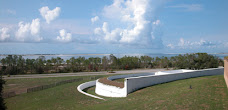
Spain first occupied Pensacola and colonized it in 1698. The French briefly held the city in 1719. The Spanish took it back and the British took it from the Spanish in 1763. The Spanish recaptured Pensacola in 1781 while the British were involved in a little skirmish along the East Coast of America. The Spanish built San Carlos de Barrancas and Bateria de San Antonio to protect the approach to Pensacola. The Bateria de San Antonio was built near the level of the beach so that shot fired at vessels would skip across the bay to strike those vessels at the waterline.

Andrew Jackson seized the Spanish Forts in 1814 and 1818. When Florida became part of the United States in 1821, the Navy chose Pensacola as its southern navy yard. The natural channel into Pensacola is from 20' to 50' deep and allows larger vessels to transit rather far into the bay.
Building the navy yard in Pensacola required protection. The US Army made improvements to the Bateria de San Antonio and constructed Ft. Barrancas on the ruins of the Spanish fort San Carlos de Barrancas. Barrancas means bluff in Spanish.
The fortification consists of 5 main parts.
The "glacis" is an earthen slope that would hide the fort from advancing ground troops and land based artillery.
The "dry moat" came next. This moat was 35' wide and required the removal of 16,000 tons of sand to form it. This moat provided protection of the "parade" from advancing ground forces. The dry moat separated the "Scarp" and the "Counter Scarp".

The counterscarp, or outer wall, provided support for the glacis and allowed cannon and rifle defences for the dry moat. Should anyone get to the dry moat they would face 130 rifle slots and 4 cannon doors. The dry moat was better known as "the killing field". The cannon used "grapeshot", one large container that broke open into 6 or 9 smaller shot.
The scarp as the main wall supported the parade and provided the defense against both ships and infantry. On the parade there were 19 cannon placements. Each cannon or mortar, on wheels, on these placements could be rotated about 120 degrees. This allowed the cannon to "track" moving vessels thus concentrating firepower. When firing at ships the cannon balls were heated red hot before firing. This would cause a fire on the fired upon vessel whether struck in the sails or the hull.
The fort itself is amazing. The walls are 4' thick. Inside the walls the bricks were hand crafted to form the arches necessary to hold back all of the dirt/sand of the parade or the glacis. I was impressed with the architecture.
For all the emphasis on defense of the harbor, the Confederacy captured the fort, the navy yard and Pensacola on January 12th, 1861. The Union Army still held Ft. Pickens across the bay from Ft. Barrancas. It is said that an errant shot fired toward Ft Pickens by the Confederate troops in Ft. Barrancas was the actual "first shot" of the Civil War. The Confederacy abandoned Ft. Barrancas in May of 1862.
Both Ft. Barrancas and Ft. Pickens served the United States until 1947 when the government declared them surplus
The Advance Redoubt took 15 years to construct and was similar to that of Ft. Barrancas. The redoubt was inland and was built to protect the fort and the navy yard from ground troops who would have to approach from the west. It to became obsolete after the Civil War.

.jpg)


